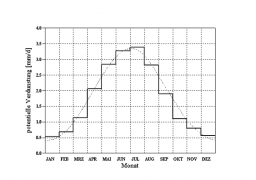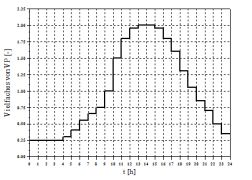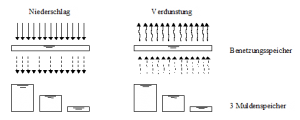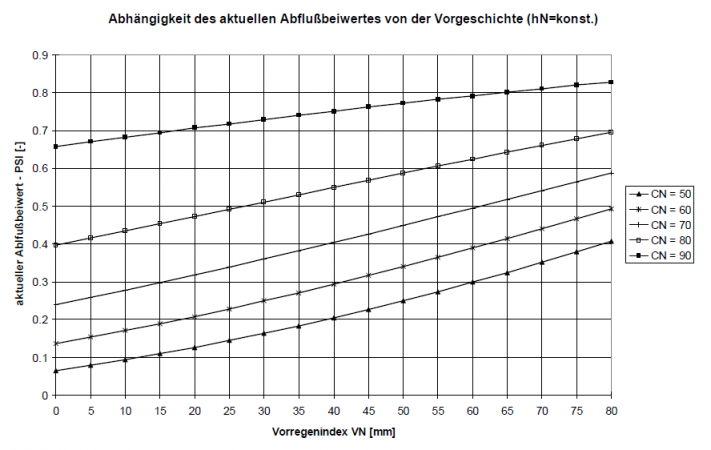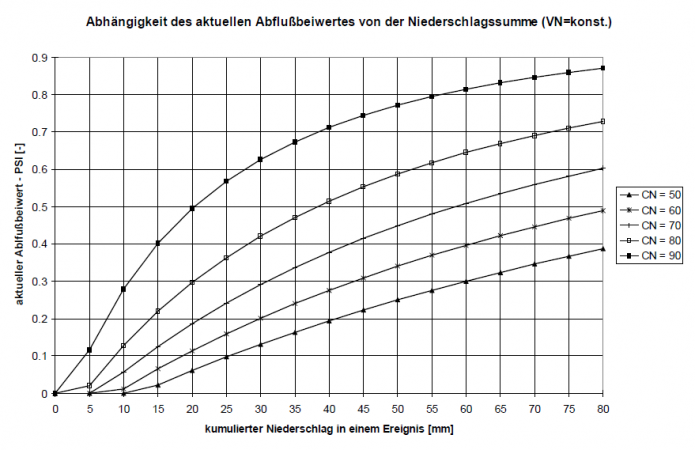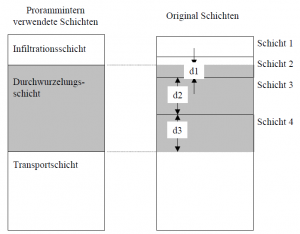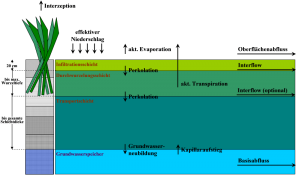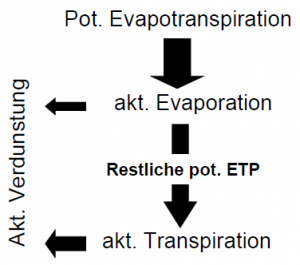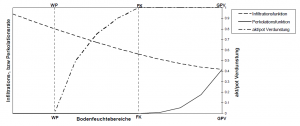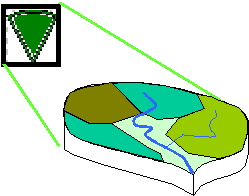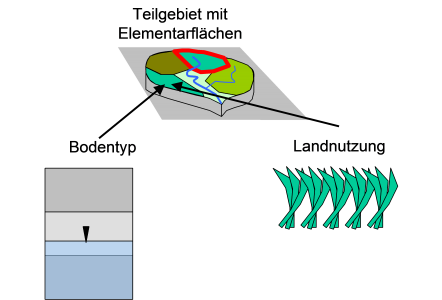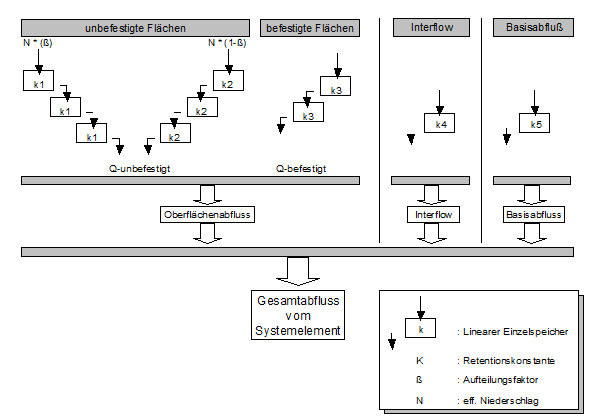Einzugsgebiet/en: Unterschied zwischen den Versionen
Keine Bearbeitungszusammenfassung |
Keine Bearbeitungszusammenfassung |
||
| Zeile 10: | Zeile 10: | ||
==Runoff generation | ==Runoff generation for impermeable surfaces== | ||
The runoff generation determines the effective precipitation from the rainfall. From this, the components surface runoff, infiltration, evaporation and interflow are derived. A snow calculation is performed at temperatures below zero °C and is based on the Snow-Compaction-Method. Regarding the algorithms of the method, reference is made to the relevant literature. | The runoff generation determines the effective precipitation from the rainfall. From this, the components surface runoff, infiltration, evaporation and interflow are derived. A snow calculation is performed at temperatures below zero °C and is based on the Snow-Compaction-Method. Regarding the algorithms of the method, reference is made to the relevant literature. | ||
Version vom 25. November 2020, 09:58 Uhr
The simulation of natural catchment areas requires calculating the processes of runoff generation, distribution and concentration. The methods of calculation used are described below.
Load Generation
Load generation is the process of determining the precipitation for the considered catchment area. In Talsim-NG, each sub-basin uses only one precipitation source. If there are several precipitation measurement stations in the catchment area, you can either divide the area into several sub-basins or aggregate precipitation sources, until only one precipitation source can be assigned to each element.
Runoff generation for impermeable surfaces
The runoff generation determines the effective precipitation from the rainfall. From this, the components surface runoff, infiltration, evaporation and interflow are derived. A snow calculation is performed at temperatures below zero °C and is based on the Snow-Compaction-Method. Regarding the algorithms of the method, reference is made to the relevant literature. The natural process from precipitation to runoff is divided into individual phases for the mathematical simulation. In the runoff generation phase, the precipitation (system load) is divided into the "effective precipitation" directly reaching the runoff, and the losses not affecting the runoff (moistening, trough, evaporation and infiltration losses). Therefore, this phase is also called load distribution. The resulting mathematical equation for the momentary load distribution is written as follows:
[math]\displaystyle{ N_W(t) =N(t) -VP(t) -I(t) - \frac{dO}{dt} - \frac{dS}{dt} }[/math]
with:
| [math]\displaystyle{ N_W }[/math]: | Runoff-effective precipitation |
| [math]\displaystyle{ N }[/math]: | Precipitation |
| [math]\displaystyle{ VP }[/math]: | Potential evaporation |
| [math]\displaystyle{ I }[/math]: | Infiltration into the floor area |
| [math]\displaystyle{ O }[/math]: | Surface water supply |
| [math]\displaystyle{ S }[/math]: | Snow storage |
In the following, the terms used in the equation and their calculation are explained in detail.
Precipitation N(t)
The precipitation data must be added to the simulation model in the form of rainfall series. In principle, it is irrelevant whether the precipitation series is a block rain, a model rain, a measured natural rain, a rain spectrum or a long-time rain series. Depending on the objective of the simulation calculation the appropriate load has to be selected. The rainfall series are either taken from the time series management of Talsim-NG or are generated, in case of applying a short term forecast, by entering a rainfall duration, a precipitation height and the choice of a rain model directly before a simulation.
Evaporation VP(t)
Evaporation has a double effect on the formation of runoff. On the one hand, the initial conditions in the catchment area (wetting and trough filling on the surface as well as limiting soil moisture on permeable surfaces) are a result of the evaporation taking place before the considered precipitation event. On the other hand, the precipitation to be calculated, which affects runoff, is reduced by the amount of the current evaporation rate. The potential (energetically possible) evaporation VP is very different in time and place and is hardly accessible for an exact calculation. From evaluated measurements of 20 stations, mean values of these stations are presented as histogram. The following compensation function was determined /BRANDT, 1979/.
[math]\displaystyle{ VP=(0.96+0.0033 \cdot i) \cdot \sin\frac{2\pi}{365}(i-148)+158 }[/math]
with:
| [math]\displaystyle{ i }[/math]: | current day of the outflow year |
| [math]\displaystyle{ i=1 }[/math]: | November 1 |
The total annual potential evaporation height is 642 mm. If no measured evaporation values are available, this normalized annual potential evaporation can optionally be used to calculate the current evaporation. If the selected calculation time interval is less than one day, the potential evaporation for each calculation time interval is finally determined by means of the displayed daily variation. If the calculation interval is less than 1 day, the daily course is not taken into account.
Surface water supply (sealed area portion)
In the case of sealed surface portions, snow supply and infiltration can be neglected, so that the balance equation is simplified as follows:
[math]\displaystyle{ N_W(t)=N(t)-VP(t)-\frac{dO}{dt} }[/math]
the surface water supply change [math]\displaystyle{ dO/dt }[/math] represents the wetting of the surface as well as the filling and emptying (by evaporation) of the troughs.
The following standard value [math]\displaystyle{ BV }[/math] is used as wetting loss for sealed surfaces.
[math]\displaystyle{ BV = 0.5 \mbox{ mm} }[/math]
The trough loss (MV) is specified by the user. The standard and simultaneously maximum value in the model is 4 mm. The trough loss represents the average value for an sloping surface. However, since the troughs are not evenly distributed and, as experience shows, drainage begins before the complete filling of the troughs has been reached everywhere, it is assumed that
- 1/3 of the sealed surface has a reduced trough loss of 1/3-MV
- 1/3 of the sealed area the average trough loss of 3/3-MV
- 1/3 of the sealed surface has an increased trough loss of 5/3-MV
has. Therefore, runoff already occurs when the precipitation reduced by the evaporation rate exceeds the wetting loss and 1/3 of the trough loss (in case of dry history). The assumptions above are schematically sketched in the following figure.
The runoff coefficient of the sealed surfaces (after covering the initial losses) is set at [math]\displaystyle{ \Psi = 1 }[/math]. When determining the sealed surface of a subcatchment area, it must be taken into account that not all paved or sealed surfaces actually drain into a sewer system. The continuous provision of the wetting and trough losses is achieved by continuous balancing of these reservoirs and evaporation.
Surface water supply (unsealed area)
The surface water supply is calculated by balancing a loss reservoir depending on the selected runoff generation approach. Details can be found in the following sections on the calculation of infiltration or runoff-effective precipitation.
Infiltration or runoff-effective precipitation I(t), NW(t)
In the case of permeable surfaces, infiltration into the soil cannot be neglected, since this has a decisive influence on the runoff. For the calculation three approaches were implemented in the model:
- Constant discharge coefficient [math]\displaystyle{ \Psi }[/math]
- Event-specific discharge coefficient based on the Soil-Conservation-Service (SCS) method
- Soil moisture simulation
Constant discharge coefficient Ψ
If a [math]\displaystyle{ \Psi }[/math] value is given, the remaining part of the precipitation in the ratio of the runoff coefficient [math]\displaystyle{ \Psi }[/math] is added to the runoff after covering the initial losses (wetting and trough loss), independent of the history and characteristics of the precipitation. If possible, this approach should be avoided, since the process of runoff formation is only roughly simplified.
Event-specific discharge coefficient based on the Soil-Conservation-Service (SCS)
If a CN value is given that is dependent on the soil type and land use (see /DVWK, 1991/), a prehistoric initial loss as well as a prehistoric relationship of the runoff coefficient from the amount of precipitation accumulated up to the time under consideration can be formulated /Zaiss, 1987/; i.e. the runoff coefficient increases with increasing precipitation in the course of the event. The quantification of the prehistory is based on the 21-day-precipitation index [math]\displaystyle{ VN }[/math]
[math]\displaystyle{ V_N=\sum_{j=1}^21 C(j)^j \cdot hN_j }[/math]
with:
| [math]\displaystyle{ hN_j }[/math]: | Precipitation height of the j-th previous day |
| [math]\displaystyle{ C(j) }[/math]: | Factor describing the influence of the j-th previous day |
The season impact is represented by a yearly variation of the factor C.
[math]\displaystyle{ C=0.05 \cdot \sin\frac{2\pi}{365}(i+0.75)+0.85 }[/math]
with:
| [math]\displaystyle{ i }[/math]: | current day of the outflow year |
As a result, the value C ranges between 0.8 < C < 0.9. This ensures that different rainfall indices are calculated for the same amount of rainfall at different times of the year and therefore a changed willingness to flow is taken into account. Depending on the prehistory quantified in this way, a current discharge coefficient can be calculated using the CN values specific to the area and valid for average prehistory conditions. The following figure shows for different CN-values how the current discharge coefficient changes depending on the prehistory. Since the runoff readiness of a catchment area changes in the course of a rainfall event due to soil moisture, the runoff coefficient is also adjusted during an event as a function of the cumulative precipitation height.
Soil Moisture Simulation
Land use
When using soil moisture simulation, it is necessary to specify the land use. From the information about land use, the rooting depth is needed to determine the thickness of the rooting layer. Further parameters of land use, which are used to calculate interception and transpiration, are
- Root depth
- Coverage rate
- Annual cycle of the degree of coverage
- Leaf area index
- Year of the leaf area index
Haude factors can be assigned to each land use for a better consideration of the evaporation by entering annual courses.
Soil type/ Soil texture
The soil moisture simulation is based on a non-linear calculation of the individual soil horizons. The soil is divided into different horizons (layers). Each layer is calculated and compared with the layers below or above (if available). The following soil physical parameters are used as parameters for the soil moisture calculation:
- Wilting point (WP)
- Field capacity (FK)
- Total pore volume (GPV)
- Saturated conductivity (kf value)
- Maximum infiltration capacity (Max.Inf.)
- Maximum rate of capillary suction (Max.Cap.)
- Assignment to a soil type: sand, silt, clay
The possible number of soil layers ranges from a minimum of one to a maximum of six. Experience has shown that the best results are achieved with a division into three layers. For this reason, the entered layers are always divided into three horizons within the program.
- Infiltration layer (standard thickness [cm] = 20)
- Rooted layer (minimum thickness [cm] = 5)
- Transport layer (minimum thickness [cm] = 5)
The calculation of the new soil properties for the layers used within the program is done by weighting them according to the given original thicknesses of the layers. In case of saturated conductivity the calculation is based on the principle of maintaining the continuity of the flow. In the case of vertical flow, the velocity v at a given flow rate in a program internal layer should have the same value due to the continuity of the flow. Thus, the hydraulic gradient is no longer constant.
[math]\displaystyle{ kf_V=\frac{\sum_{i=1}^n d_i}{\sum_{i=1}^n \frac{d_i}{k_i}} }[/math]
with:
| [math]\displaystyle{ d_i }[/math]: | proportional layer thickness of the respective original layer [mm] |
| [math]\displaystyle{ k_i }[/math]: | saturated conductivity of the respective original layer [mm/h] |
| [math]\displaystyle{ kf_V }[/math]: | saturated conductivity of the layer used within the program [mm/h] |
The water balance equation for a soil layer is solved on the basis of the area-wise linear representation of the process functions infiltration, current evaporation (evaporation + transpiration), percolation, interflow and capillary suction, which influence soil moisture. The input variable for evaporation and transpiration is determined from the potential evaporation. The equation to be solved is:
[math]\displaystyle{ \frac{dBF(t)}{dt}=Inf(t)-Perk(t)-Eva_{akt}(t)-Trans_{akt}(t)-Int(t)+Kap(t) }[/math]
with:
| [math]\displaystyle{ BF(t) }[/math]: | current soil moisture |
| [math]\displaystyle{ Inf(t) }[/math]: | Infiltration into the soil |
| [math]\displaystyle{ Perk(t) }[/math]: | Percolation (seepage) |
| [math]\displaystyle{ Eva_{akt}(t) }[/math]: | current evaporation |
| [math]\displaystyle{ Trans_{akt}(t) }[/math]: | current transpiration |
| [math]\displaystyle{ Int(t) }[/math]: | interflow |
| [math]\displaystyle{ Kap(t) }[/math]: | capillary suction |
Infiltration, percolation, evaporation, transpiration, interflow and capillary suction depend on the current soil moisture. In the simulation, this dependence is described by the following function courses.
[math]\displaystyle{ Inf(BF(t))=a_v \cdot \left(GPV-BF(t) \right)^{1.4}+k_f }[/math] (Approach according to HOLTAN)
[math]\displaystyle{ Perk(BF(t)) = \begin{cases} 0, & BF(t)\le f_{PK} \cdot nFK + WP \\ k_f \cdot \left(\frac{BF(t)-(f_{PK} \cdot nFK +WP)}{GPV-(f_{PK} \cdot nFK +WP)} \right)^{exp,PK}, & BF(t)\gt f_{PK} \cdot nFK + WP \end{cases} }[/math]
- (mod. Ansatz nach /OSTROWSKI, 1992/)
[math]\displaystyle{ Eva(BF(t)) = \begin{cases} 0, & BF(t)\le WP \\ f_{Eva} \cdot \left(\frac{BF(t)-WP}{GPV-WP} \right)^{exp,PK}, & BF(t)\gt WP \end{cases} }[/math]
[math]\displaystyle{ Trans(BF(t)) = \begin{cases} 0, & BF(t)\le f_{Trans} \cdot nFK + WP \\ f_{Trans} \cdot \left(\frac{BF(t)-(f_{Trans} \cdot nFK +WP)}{GPV-(f_{Trans} \cdot nFK +WP)} \right)^{exp,PK}, & BF(t)\gt f_{Trans} \cdot nFK + WP \end{cases} }[/math]
with:
| [math]\displaystyle{ a_v }[/math]: | infiltration factor according to HOLTAN (in Talsim-NG [math]\displaystyle{ a_v=1 }[/math] |
| [math]\displaystyle{ k_f }[/math]: | coefficient of permeability of saturated soil |
| [math]\displaystyle{ nFK }[/math]: | usable field capacity ([math]\displaystyle{ nFK=FK-WP }[/math]) |
| [math]\displaystyle{ WP }[/math]: | wilting point |
| [math]\displaystyle{ FK }[/math]: | field capacity |
| [math]\displaystyle{ GPV }[/math]: | total pore volume |
| [math]\displaystyle{ f_{PK} }[/math]: | soil-dependent scaling factor of the percolation function |
| [math]\displaystyle{ exp,PK }[/math]: | soil-dependent curvature parameter of the percolation function |
| [math]\displaystyle{ f_{Eva} }[/math]: | soil dependent scaling factor of the evaporation function |
| [math]\displaystyle{ f_{Trans} }[/math]: | soil-dependent scaling factor of the transpiration function |
| [math]\displaystyle{ exp,Trans }[/math]: | curvature parameters of the transpiration function |
The program parameters are calculated internally. The user only has to specify the soil parameters kf, WP, FK and GPV. The calculation of the soil processes is done with a newly developed component for the simulation of reservoirs.
Elementary surfaces
If the runoff generation is calculated with the soil moisture simulation, the elementary surface concept is applied at the same time. A catchment area element is thereby divided into any number of hydrologically homogeneous areas, i.e. areas of the same soil type and the same land use. For each elementary area there is exactly one assignment of land use and soil type. The amount of water resulting from an elementary surface is set at the element exit, i.e. all elementary surfaces release water with the same time delay, independent of their location in the catchment area.
Runoff concentration
The runoff concentration determines the delay of surface runoff from the catchment area. A parallel storage cascade with three reservoirs for unpaved and one cascade for paved areas is used. The outflow of the components interflow and groundwater is delivered delayed to the element outlet via a linear single storage tank.

